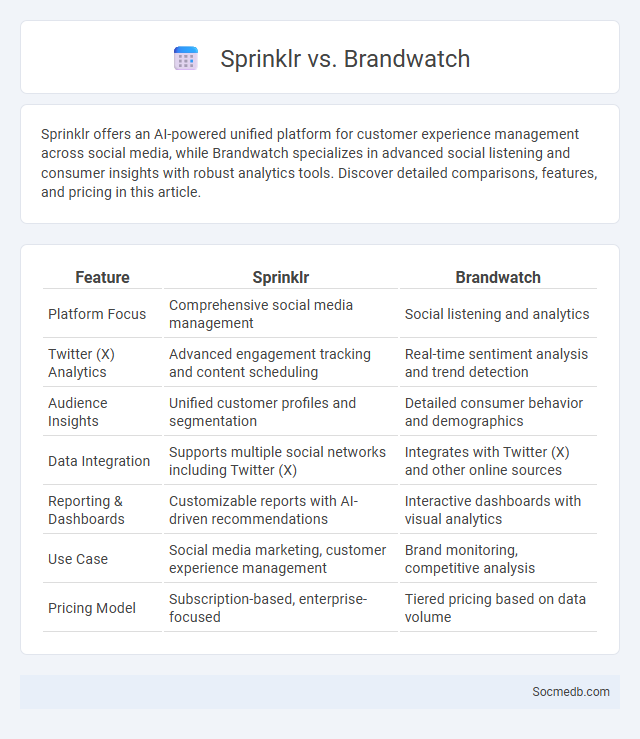
Photo illustration: Sprinklr vs Brandwatch
Sprinklr offers an AI-powered unified platform for customer experience management across social media, while Brandwatch specializes in advanced social listening and consumer insights with robust analytics tools. Discover detailed comparisons, features, and pricing in this article.
Table of Comparison
| Feature | Sprinklr | Brandwatch |
|---|---|---|
| Platform Focus | Comprehensive social media management | Social listening and analytics |
| Twitter (X) Analytics | Advanced engagement tracking and content scheduling | Real-time sentiment analysis and trend detection |
| Audience Insights | Unified customer profiles and segmentation | Detailed consumer behavior and demographics |
| Data Integration | Supports multiple social networks including Twitter (X) | Integrates with Twitter (X) and other online sources |
| Reporting & Dashboards | Customizable reports with AI-driven recommendations | Interactive dashboards with visual analytics |
| Use Case | Social media marketing, customer experience management | Brand monitoring, competitive analysis |
| Pricing Model | Subscription-based, enterprise-focused | Tiered pricing based on data volume |
Introduction to Social Listening Tools
Social listening tools analyze online conversations and trends across platforms like Twitter, Facebook, and Instagram to provide actionable insights about your brand reputation and customer sentiment. These tools track keywords, hashtags, and competitor mentions, enabling you to identify emerging issues and opportunities in real time. By leveraging social listening, your marketing strategy becomes data-driven, enhancing engagement and customer satisfaction.
Overview: Sprinklr vs Brandwatch
Sprinklr offers an all-in-one platform designed for comprehensive social media management, including publishing, engagement, and analytics, making it ideal for enterprises seeking unified solutions. Brandwatch specializes in advanced social listening and consumer insights, leveraging AI-powered analytics to track brand reputation and market trends across diverse social channels. Your choice depends on whether you prioritize integrated social media execution or deep data-driven audience intelligence.
Core Features Comparison
Social media platforms differ significantly in core features such as content sharing formats, user interaction mechanisms, and privacy settings. Facebook emphasizes diverse content types including text, photos, and live videos, with robust community building tools and detailed privacy controls. Instagram prioritizes visual storytelling through photos and short videos, featuring Stories and Reels for ephemeral and engaging content, while Twitter centers on concise, real-time text updates and trending topic discussions with threaded replies.
Data Sources and Coverage
Social media platforms generate vast data sources including user posts, comments, likes, shares, and multimedia content across millions of active users globally. Coverage spans multiple platforms such as Facebook, Twitter, Instagram, LinkedIn, TikTok, and emerging networks, offering diverse demographic and geographic insights. This extensive data capture enables comprehensive analysis of trends, sentiment, behavior, and real-time social dynamics.
Analytics and Reporting Capabilities
Social media platforms offer advanced analytics and reporting capabilities that enable businesses to track engagement metrics, audience demographics, and campaign performance in real-time. Tools like Facebook Insights, Twitter Analytics, and Instagram Insights provide detailed reports on reach, impressions, click-through rates, and conversion rates, facilitating data-driven marketing strategies. These comprehensive analytics help optimize content, improve targeting, and measure return on investment (ROI) effectively across various social networks.
User Experience and Interface
Social media platforms prioritize intuitive user experience by streamlining navigation and ensuring fast load times to foster engagement. Interface design employs visually appealing elements like consistent color schemes, readable typography, and interactive icons to enhance usability and accessibility. Continuous user feedback and A/B testing refine features, optimizing interface responsiveness across devices and boosting overall satisfaction.
Integration and Customization Options
Social media platforms offer extensive integration and customization options to enhance your brand's online presence and streamline workflow across channels. Tools like API access, customer relationship management (CRM) connectors, and automated posting schedules enable seamless synchronization with existing marketing systems, boosting efficiency. Customizable content templates and targeted audience settings allow you to tailor your messaging for maximum engagement and relevance.
Pricing and Plans
Social media platforms offer diverse pricing models, including free access with ads, freemium plans with premium features, and subscription-based options tailored for businesses. Paid plans often include advanced analytics, enhanced advertising tools, and increased content reach, with prices ranging from $10 to over $100 per month depending on the platform and level of service. Custom enterprise solutions provide scalable options designed for large organizations seeking comprehensive social media management and targeted marketing campaigns.
Customer Support and Training
Social media platforms revolutionize customer support by enabling instant communication and real-time issue resolution, enhancing customer satisfaction and loyalty. Your brand can leverage interactive tutorials, live webinars, and community groups on social media to provide effective training and empower users with accessible knowledge. Integrating social media analytics helps identify common customer pain points, allowing tailored support strategies that improve overall service quality.
Which Social Listening Tool Is Right for You?
Choosing the right social listening tool depends on your specific goals, budget, and the platforms you prioritize. Tools like Brandwatch and Sprout Social offer comprehensive analytics for large enterprises, while Hootsuite and Mention cater to small businesses with user-friendly interfaces and real-time monitoring. Evaluate features such as sentiment analysis, keyword tracking, and integration capabilities to ensure the tool aligns with your social media strategy and helps you better understand Your audience's conversations.
 socmedb.com
socmedb.com